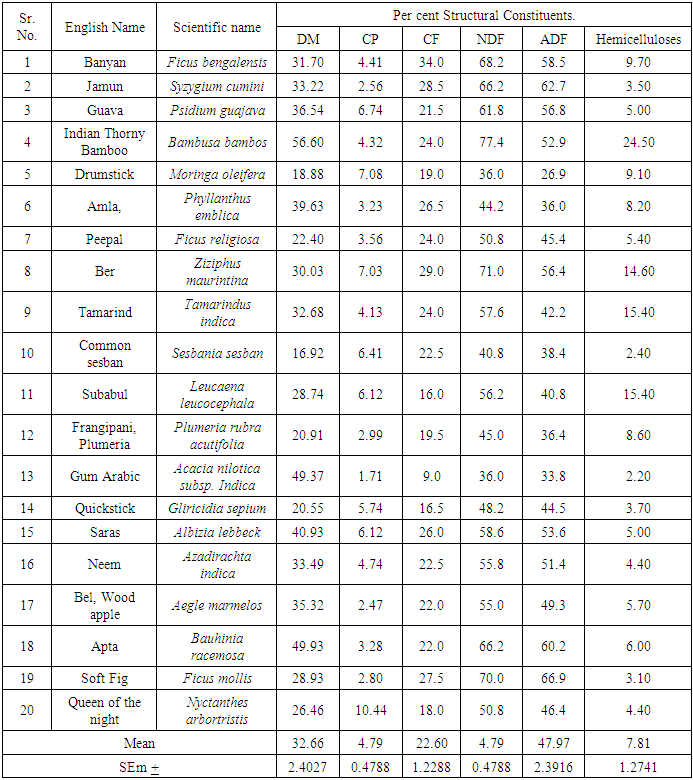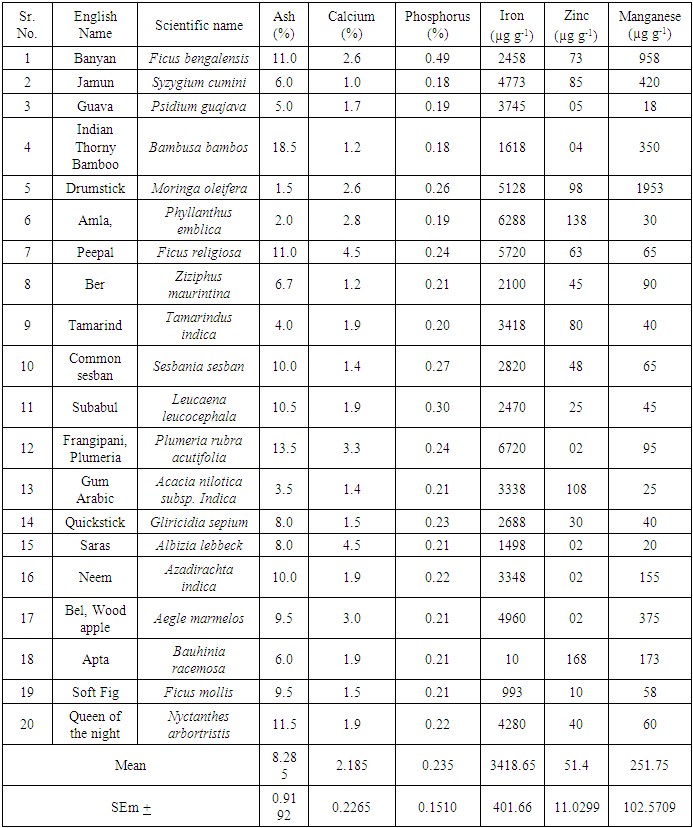-
Paper Information
- Paper Submission
-
Journal Information
- About This Journal
- Editorial Board
- Current Issue
- Archive
- Author Guidelines
- Contact Us
Advances in Life Sciences
p-ISSN: 2163-1387 e-ISSN: 2163-1395
2017; 7(1): 11-14
doi:10.5923/j.als.20170701.03

Nutritional Status of Fodder Tree Leaves and Shrubs of Scarcity Zone of Maharashtra1
U. S. Gaikwad, A. B. Pawar, A. D. Kadlag
National agricultural Research Project, Zonal Agricultural Research Station, Solapur (M.S.), India
Correspondence to: U. S. Gaikwad, National agricultural Research Project, Zonal Agricultural Research Station, Solapur (M.S.), India.
| Email: |  |
Copyright © 2017 Scientific & Academic Publishing. All Rights Reserved.
This work is licensed under the Creative Commons Attribution International License (CC BY).
http://creativecommons.org/licenses/by/4.0/

The intent of this experiment was to figure out the nutritive value of fodder tree leaves and shrubs of dryland area in Solapur district, Maharashtra. The climate of this region is characterized by a relatively low annual rainfall (594.8 mm) and it varies from 594.8 to 655.6 mm from year to year. Temperature during winter is 22.5°C and summer 40.1°C. The average annual total evaporation is 2817.7 mm. Leaves of fodder trees and shrubs were selected and analyzed for dry matter (DM), organic matter (OM), ash, crude protein (CP), neutral detergent fiber (NDF), acid detergent fiber (ADF), hemicelluloses and proximate composition. The mean per cent values for DM, CF, CP, NDF, ADF, and hemicelluloses were 32.66, 22.60, 4.79, 55.75, 47.97 and 7.81 per cent respectively. The average per cent of ash, calcium and phosphorus in fodder tree leaves and shrubs were 8.28, 2.18 and 0.235 respectively. Where, iron, zinc and manganese were 3419, 51 and 252 µg g-1 respectively.
Keywords: ADF, Fodder tree leaves, NDF, Nutritional evaluation, Proximate composition, Shrubs
Cite this paper: U. S. Gaikwad, A. B. Pawar, A. D. Kadlag, Nutritional Status of Fodder Tree Leaves and Shrubs of Scarcity Zone of Maharashtra1, Advances in Life Sciences, Vol. 7 No. 1, 2017, pp. 11-14. doi: 10.5923/j.als.20170701.03.
1. Introduction
- The current status of animal protein deficiency in developing world is caused by lack of forage.Fodder tree and shrubs have always played a role in feeding livestock. Trees and shrubs are increasingly recognized as important component of animal feeding, especially as supplies of protein. In dryland areas, where the available grazing is not sufficient to very low and erratic, ill distributed rainfall, to meet the maintenance requirement of animal for part of the year. The contribution from trees and shrubs is significant. The fodder contains high level of crude protein, mineral matter and digestibility. They are really acceptable by the livestock, because of their deep root system; they continue to produce well in to the dry season.Fodder trees and shrubs species are considered important contributor to grazing livestock nutrition in rainfed areas. It is also used as supplement to low quality feeds. During the dry and crop fallow season, farmers traditionally feed indigenous fodder species to meet nutritional requirement of grazing livestock. Fodder tree leaves are an alternative source of livestock feeding in scarcity period especially prolonged dry spell. As there is little information regarding the nutritive value of fodder tree leaves and shrubs, so the study was conducted to establish the nutritive values of the fodder tree species and shrubs of dryland areas of Solapur district of Maharashtra.
2. Materials and Methods
- The field survey experiment was conducted in dryland areas of Solapur district of Maharashtra to determine the nutritive value of leaves from locally available fodder tree species and shrubs. The study area is located within 17° 10' and 18°32' north latitudes and 74°42' and 76°15' east longitudes with 483.63m elevation from MSL and having dry environment. The average precipitation varies from 594.8mm and varies 594.8 to 655.6 mm from year to year annually. The fodder tree leaves and shrubs samples were collected from growing tip, middle and basal section of tree and shrubs.The air dried fodder tree leaves and shrubs samples were further dried in hot air oven at 60°C till constant weight and analyzed for dry matter (DM), crude protein (CP), and crude fiber (CF). The samples were also analyzed for neutral detergent fiber (NDF), acid detergent fiber (ADF), hemicelluloses and proximate (AOAC, 1016). The dry matter was determined by drying the sample at 70°C ± 2 till constant weight. Crude protein was estimated by Micro-Kjelhhad method. Oven dried sample was digested with Conc. H2SO4 in presence of 30% H2O2. A known liquid of diluted sample was distilled in presence of saturated NaOH and nitrogen was collected in 2% H3BO3. The distillate was titrated against standard 0.02 N H2SO4. The per cent of nitrogen was calculated for the estimation of crude protein. For crude fiber, sample was rinsed first with 1.25% HCl and subsequently with 1.25% NaOH for 30 minute each to dissolve acid and alkali soluble component present in it. The residue containing crude fiber was dried to constant weight and calculated the crude fiber.
3. Results and Discussion
- Dry matter (DM) is the actual amount feed material excluding water, volatile acid and bases if present. The dry matter content of various fodder tree leaves and shrubs used for feeding livestock was varied from 16.92 to 56.60 per cent. Most of the samples contained dry matter more than 30 per cent (Table 1.). The highest dry matter values was observed in Bambusa bambos (56.60%) followed by Bauhinia recemose (49.93%), Acacia nilotica (49.37%) and Albizia lebbeck (40.93%). High dry matter content could be due to the time of sampling November to January, after six months little new growth (Atiya Azim et.al. 2011). The crude protein content was varied between 10.44 to 1.71 per cent. It was the highest in Nyetanthes arbortritis (10.44%) and the least in Acacia nilotica (1.71%). Moringa olifera, Ziziphus mauritina, Psidiun guajava, Sesbania sesban and Leucana leucocephala were recorded the protein content 7.08, 7.03, 6.74 and 6.41 per cent respectively. Syzygium cumini, Michelia alba, Acacia nilotica, Aegle marmelos and ficus microcapara were recorded the less content of crude protein (2.56, 2.99, 1.71, 2.47 and 2.80 per cent respectively). The finding was in the line with those of Bakshi and Wadhwa (2004).The crude fiber content of fodder tree leaves and shrubs were ranged between 34.0 to 9.0 per cent. It was the highest Ficus bengalensis (34.0%). It was followed by Zizipus maurintina (29.0%), Syzygium cumini (28.5%).Structural ConstituentsThe structural constituents of fodder tree leaves and shrubs are presented in Table-1. The neutral detergent fiber was varied from 77.4 per cent (Bambusa bambos) to 36.0 per cent (Moringa olifera and Acacia nilotica). The acid detergent fiber content in these fodder species were 52.9 per cent (Bambusa bambos) and 26.9 and 33.8 per cent (Moringa olifera and Acacia nilotica). The hemicelluloses per cent of fodder tree leaves varied between 24.1 (Bambusa bambos) to 2.2 (Acacia nilotica). The variation in NDF and ADF and hemicelluloses of the fodder tree leaves and shrubs might be associated with maturity of fodder species (Hameed et.al. 2008).
|
|
4. Conclusions
- Current investigation on nutritional evaluation of foliage have revealed that these fodder tree leaves and shrubs are good source of nutrient (protein, fiber and minerals) and can be used for livestock feeding in this specific districts of scarcity zone of Maharashtra.
Note
- 1. *This work was supported by the National Agricultural Research Project, Solapur (M.S.) India.
 Abstract
Abstract Reference
Reference Full-Text PDF
Full-Text PDF Full-text HTML
Full-text HTML
